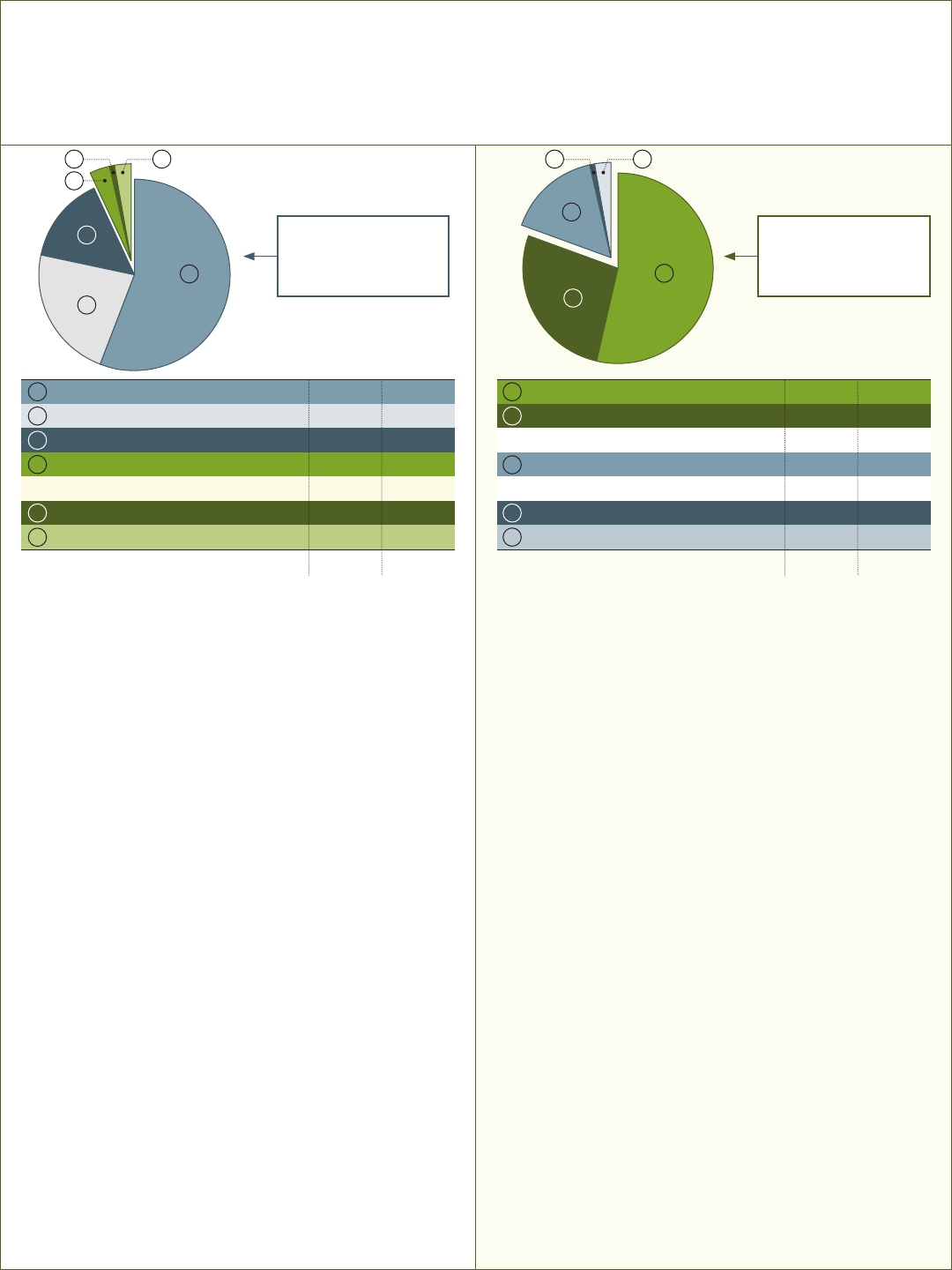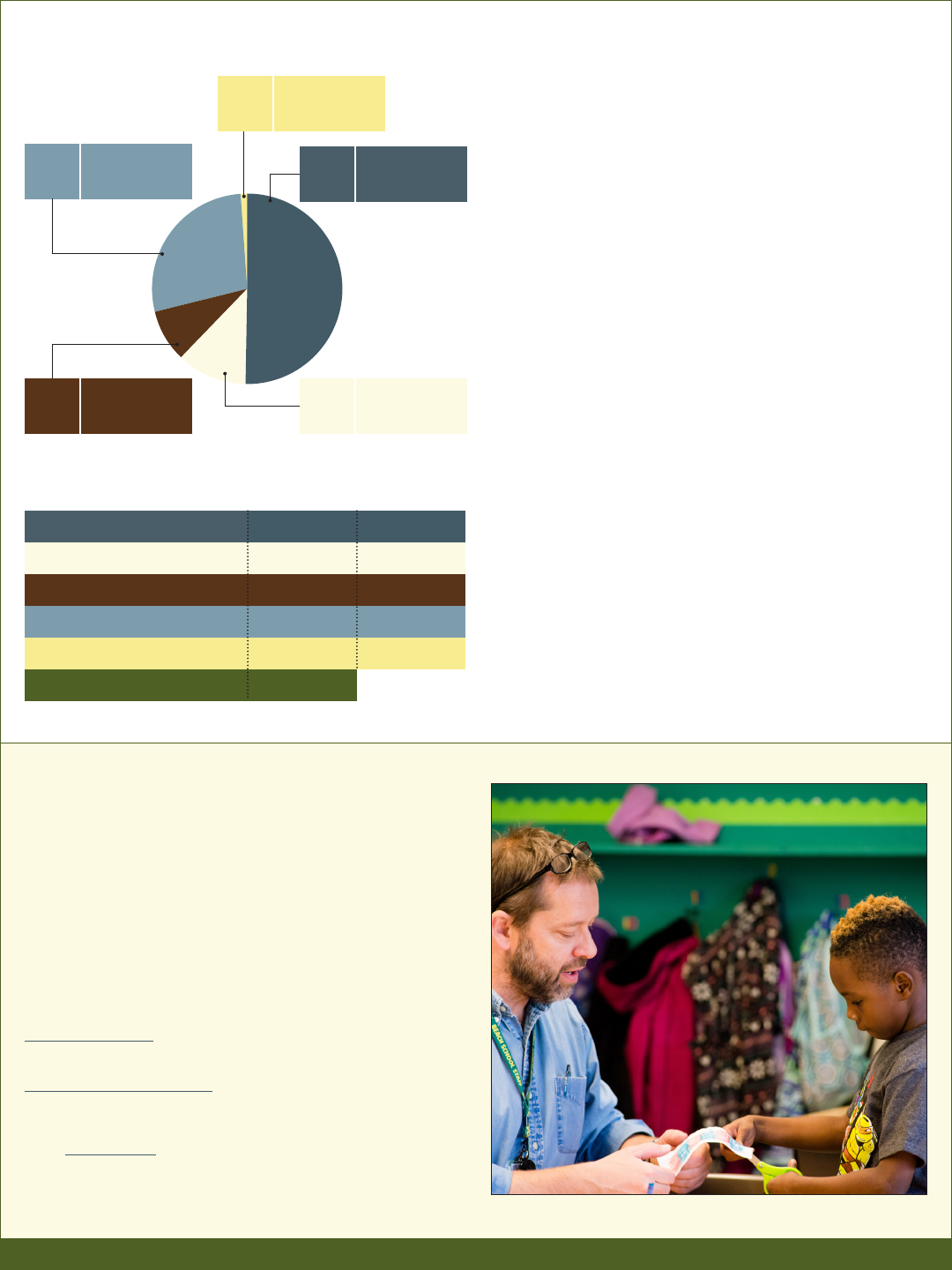
The largest portion of general fund revenue comes from the state school fund.
The Oregon Department of Education determines the total funding that each
district receives through a formula that includes:
• The amount of funding appropriated by the state legislature.
• The estimated permanent rate property taxes collected statewide.
• The number of students in the district, weighted for average teacher
experience, the number of special education and emerging bilingual students,
and other factors.
In the 2016-17 adopted budget the state school fund accounts for 74% of the
funds – with permanent rate property taxes at $215.9 million (36.4% of total
funds) and the state school fund at $222.8 million (37.6%).
PPS collects local option property taxes of $81.7 million (13.8%) in this budget
and also $23.1 million of other local property tax (3.9%). The local option is a
ve-year voter-approved levy that was most recently approved in November
2014. Remaining sources of funds include the beginning fund balance, which
is carried over from the prior year and includes the district’s general fund
contingency reserves. This balance accounts for $25.7 million (4.3%) in the
current budget.
Finally there is $23.4 million (3.9%) of other revenue, which includes funds
received via the Multnomah Education Service District ($8.5 million), the City
of Portland arts income tax ($4.5 million), overhead charged to grants ($4.2
million), and income from leasing and renting district facilities ($2.3 million).
Additional detail behind the sources of these funds can be found on p. 70 of the
adopted budget document.
PORTLAND PUBLIC SCHOOLS
UNDERSTANDING THE PPS BUDGET: 201617
School budgets are not easy to read or understand.
In response, we have produced this four-page document
to provide an easy-to-understand summary of the PPS
budget and to answer the questions we hear most often
about our general fund budget:
• Where does the money come from?
• What does the money pay for?
• How are schools funded?
• What about other funds?
Where does the money in the PPS general fund budget come from?
Beginning Fund Balance
2016/17($ millions)
Total $592.6
$23.4
$23.1
$81.7
$438.7
$222.8
$215.9
$25.7
100.0%
3.9%
3.9%
13.8%
74.0%
37.6%
36.4%
4.3%
Other Revenue
Property Tax – Other
Subtotal – State School Fund Formula
State School Fund Allocation
Property Tax – Local Option
Permanent Rate – Property Taxes
Permanent Rate –
Property Taxes
$215.9 million
36.4%
State School Fund
Allocation
$222.8 million
37.6%
Property Tax –
Local Option
$81.7 million
13.8%
Property Tax –
Other
$23.1 million
3.9%
Other
Revenue
$23.4 million
3.9%
Beginning
Fund Balance
$25.7 million
4.3%

What does the money in the general fund budget pay for?
The largest share of PPS general fund budget goes to direct instruction,
which includes classroom teachers, special education and ESL teachers,
educational assistants, textbooks, and supplies. In 2016/17 PPS allocated
$332.3 million (56.1%) of its general fund budget to these uses.
The second largest allocation is for classroom support, which includes
librarians/media specialists, counselors, school principals, school psychologists,
attendance coordinators, extra-curricular activities, and other classroom
support activities. In 2016/17 PPS allocated $132.6 million (22.4%) of its
general fund budget to these uses.
Also directly impacting schools and students is building support, which
includes student transportation, utilities, maintenance, custodians, printing,
purchasing, technology services, and other building support. In 2016/17 PPS
allocated $86.5 million (14.6 %) of its general fund budget to these uses.
The nal category of operating costs is for central support/administration,
which includes the superintendent’s oce, public information, testing, legal,
nance, payroll, budgeting, human resources, and supervision of instruction.
In 2016/17 PPS allocated $20.5 million (3.5%) of its general fund budget to
these uses.
Debt service and fund transfers includes interest and principal payments on
borrowed funds and transfers to facilities and IT capital funds. In 2016/17 PPS
allocated $5.4 million (0.9%) of its general fund budget to these uses.
The nal category is contingency/reserves, which includes savings for
emergencies and unforeseen changes to revenues and expenditures, insurance
liabilities, and any specic committed reserve funds. In 2016/17 PPS allocated
$15.2 million (2.6%) of its general fund budget to these uses, of which $1.5
million is specically allocated to a self-insurance reserve.
More specic details of expenditures by program can be found on pp. 71-74 of
the adopted budget.
What does the PPS general fund pay for (looked at
another way)?
The previous breakout of budgeted spending was by program. The alternative
is by account category. As these gures show clearly, PPS spends most of its
budget on people, with $478.3 million (80.7 %) of the 2016/17 budget going
for salaries and benets for employees.
Only $93.7 million (15.8%) is spent on non-personnel products and services,
with the largest categories being $23.2 million (3.9%) for charter and
alternative schools, $18.5 million (3.1%) for property services and utilities,
$12.8 million (2.2%) for supplies and materials, including textbooks and
curriculum materials, and $13.9 million (2.3%) for transportation services.
Travel, which is an area we are often asked about, is only $0.5 million (0.1%).
Debt Service and Fund Transfers is $5.4 million (0.9%) and Contingency/
Reserves is $15.2 million (2.6%).
More specic detail of expenditures by account category can be found on
pp. 89-92 of the adopted budget.
There are two ways to answer this question, either by program or by account category. Programmatic use separates spending by teachers in classrooms, classroom and
building support, central administrative services and other programs, while categories of spending includes all programs but breaks out salaries and benets, supplies and
materials, services, etc.
Direct Instruction – Teachers and textbooks
2016/17
Total $592.6
$15.2
$5.4
$571.9
$20.5
$86.5
$132.6
$332.3
100.0%
2.6%
0.9%
96.5%
3.5%
14.6%
22.4%
56.1%
Contingency/Reserves
Debt Service and Fund Transfers
Central Support/Administration
Building Support – Buses, buildings and more
Subtotal – Operating Costs
Classroom Support – School sta and support
Salaries
2016/17
Total $592.6
$15.2
$5.4
$571.9
$93.7
$478.3
$159.8
$318.5
100.0%
2.6%
0.9%
96.5%
15.8%
80.7%
27.0%
53.7%
Contingency
Transfers & Debt Service
Subtotal – Non-Personnel
Subtotal – Salaries & Benets
Total Operating Costs
Benets
A
B
D
C
E
F
A
B
C
E
D
A
B
D
C
E
A
B
D
C
F
E
93% of the PPS general
fund budget impacts schools
and students directly
81% of the general fund is
dedicated to people

How do we fund each of the schools?
The largest investment we make in our schools is to pay for stang – the teachers, secretaries, principals, and other individuals working in schools. We refer to these
as FTEs or full-time equivalents, which are allocated to individual schools using the following approach:
Stang Assigned by Number of Students – The largest stang
allocation for each school is based on the number of students served. This
is mostly used to provide teachers and educational assistants. Positions are
designated in licensed FTEs, where one teacher equals two classied sta
members (e.g., secretary, clerk, educational assistant). Therefore, only 0.5
FTE is needed to hire a full-time secretary and 0.25 FTE is needed to hire
a half-time educational assistant. Kindergarten is covered by a separate
allocation. PPS uses stang ratios that are reviewed every year, and are
described on p. 36 of the adopted budget.
Equity Allocations – Some schools receive extra funding based on the
number of students qualifying for free or reduced-price meals and the
number of historically underserved students (Black, Latino, Native American,
Pacic Islander, learning English, and Special Education). Nineteen of 31 K-5
schools; 20 of 26 K-8s; 8 of 11 middle schools; and all 10 high schools receive
an equity allocation to provide extra support to students in need.
School-Wide Support – This allocation is based on a school’s needs due to
size and conguration (K-5, K-8, K-12, middle and high schools). Positions
include principals, vice principals, assistant principals, media specialists,
and school secretaries. Schools serving students in K-5 receive arts teacher
stang, funded by the City of Portland arts income tax.
Sta for Special Circumstances – Sta are allocated to address specic
considerations (such as split campus, recent changes, unique programs, etc.).
Additional sta are also allocated to support the ability of schools to oer
the core program (each spring for the following school year) and to address
higher-than-forecast student numbers and large class sizes (each fall).
Kindergarten
We sta kindergarten separately. Initial kindergarten teacher and educational
assistant allocation is based on the number of students projected to be enrolled
and a maximum class size of 26. Additional resources may be allocated in the fall
based on the number of students enrolled.
In 2015-16 Kindergarten was funded for a full-day by the state for the rst time.
In PPS schools with Kindergarten and where more than 50% of the students are
identied as historically underserved (26 of 57 schools), PPS provides additional
support through allocation of a half-time educational assistant in each
kindergarten classroom. Additionally, at 23 of these 26 schools, federal Title I
funds pay to make the educational assistants full time. This investment has been
made in support of the PPS third grade reading priority, which is focused on
ensuring that all children in PPS can read-to-learn by third grade.
Special Education and English as a Second Language (ESL)
Both Special Education and ESL programs provide sta in the schools. Each school
has some FTE allocation from each of these programs, based upon the number of
eligible students (see pp. 42-44 in adopted budget). Both programs are supported
by a combination of general fund and grant/special revenue funds.
Other funds
In addition to the general fund stang, schools may also receive funds via Title I,
raise funds through foundation activity, and receive grants.
Title I: Schools with higher numbers of students in poverty (measured by
percentage of students qualifying for free meals) receive federal Title I funds.
Schools receive a dollar amount per qualifying student. These funds may be used
to fund stang and/or to provide support and services to these students and
their families. In 2016-17 there are 9 K-5, 14 K-8, 2 middle schools and 3 high
schools that receive Title I funding.
Foundation and PTA funds: A number of schools raise money through
parent-led fundraising to support school stang and other activities, through
foundations. Use of funds for non-stang activity is at the discretion of each
school. Funds to pay for additional stang are subject to sharing; one-third of
the dollars raised by local school foundations (after the rst $10,000) is set aside
in an equity fund administered for PPS by All Hands Raised, which uses a formula
to fund grants to PPS schools each spring.
Discretionary Budgets: The amount of discretionary funds (referred to as
consolidated budget) each school receives is partly based upon the number of
students at the school. The amounts range from $35,000 for a small K-5 school to
$190,000 for a large high school. Principals use these funds to pay for such things
as supplies, limited-term personnel, printing costs, some teacher extended
responsibility, library books and materials, copy machines and toner, eld trips,
and substitute costs not covered centrally.
Schools do not pay for utilities, custodians, or maintenance work. These services
are budgeted centrally in the Facilities department.
A more detailed description of the school stang formulas and the allocations
by school is published in the PPS budget. It begins on p. 33 in the 2016/17
adopted budget.
Sta assigned
by number
of students
Sta assigned
by equity
allocation
School-wide
support
Sta for special
circumstances

The PPS scal year runs from July 1 to June 30. Figures in this document are from
the PPS adopted budget. Some items are hard to estimate (e.g. local option
revenue) or change after the budget is adopted (e.g. state school fund allocation)
and are revised in budget amendments approved by the board during the year.
We would like to thank the PPS Community Budget Review Committee for
encouraging us to develop this summary and for working with us to improve the
nal product.
To learn more:
View the PPS adopted budget for 2016/17:
http://bit.ly/PPSbudget
View the Superintendent’s budget framework:
http://bit.ly/PPSbudgetframework
Please send any questions or comments to Lori Baker, Deputy Chief Financial
Ocer, [email protected].
What about other funds?
Portland Public Schools is an armative action and equal opportunity employer.
Most of this information has been about the PPS general fund – because that’s
the primary day-to-day operating fund for the district.
In addition, PPS budgets and accounts for money in a number of other funds:
PPS has Special Revenue Funds which include specically dedicated revenues
such as federal, state and local grants, the school meals program fund ($24.3
million) and a PERS stabilization fund ($16.7 million). Also included in these
funds are Title I ($12.7 million), IDEA ($12.0 million) and both day and residential
treatment programs ($6.8 million), funding for regional programs for deaf
and hard of hearing ($15.0 million), Head Start ($10.0 million), GEAR Up grant
to improve college readiness ($3.2 million), and school foundation funds
($2.9 million).
PPS has ve Debt Service Funds which provide for the payment of principal
and interest on long-term debt, including PERS debt ($45.7 million) and capital
bonds ($49.7 million).
PPS has eight Capital Project Funds for the acquisition of technology, or the
construction or renovation of school facilities. The largest of these is funded by
the 2012 school capital improvement bond program ($270.6 million). Some of
that money is budgeted to be spent in future years.
Internal Service Funds are for services provided internally on a cost-
reimbursement basis. PPS has one fund which accounts for self-insurance for
workers compensation.
There is a summary of the 2016/17 budget by fund type on p. 11 of the adopted
budget, a list of each fund and the amount in the 2016/17 budget on p. 60, and
summaries of where the money comes from and how it is to be spent on pp. 65-69.
Total By
Fund Type
$1,155.9All Funds
Fund Type as %
of All Funds
($ millions)
$592.6General Fund 51%
$135.9 Special Revenue 12%
$99.7Debt Service 9%
$320.5Capital Projects 28%
$7.2Internal Service 1%
Capital Projects
$320.5 million
28%
Internal Service
$7.2 million
1%
Special Revenue
$135.9 million
12%
Debt Service
$99.7 million
9%
General Fund
$592.6 million
51%
